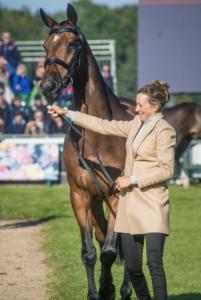Any rider has had the experience. You see something in the distance that will most definitely send your horse into a spiral: be it a deer on the trails, a wayward tarp, or the world-shattering open umbrella. Unbeknownst to you, your heart starts to beat faster as your brain prepares for a spook, and before your horse even sees the threat, he’s tense, too.
In these situations, we’ve been taught that a deep breath goes a long way; that horses can sense our fear, and by staying calm, our energy will transfer into them. But did you know that there’s actual science behind this horsemanship?
Horses have incredible hearing, with the ability to hear the heartbeat of a human from four feet away. In the wild, horses will synchronize their heartbeats to the other horses in the herd in order to sense danger more quickly, and recent studies have shown that they use those tactics in domesticated life as well. When our horses interact with us, they tend to synchronize to our heartbeats as well, meaning they can sense slight adjustments in our mood. This means when us riders get nervous about something, we inadvertently translate our fears and anxieties onto our horses.
In her study, “Investigating Horse-Human Interactions: The Effect Of A Nervous Human,” Linda Keeling, PhD, tested the relationship between human and horse heart rate with fear as an indicator. The study had twenty participants of varying riding ability walk or ride their given horse from Point A to Point B four times, and participants were told that on the fourth pass an umbrella would open. The umbrella was never opened, but the heart rates of both the riders and horses increased in anticipation when the human expected the umbrella to open.
“The increase in the horses’ heart rates probably means that they are more alert and prepared to react to any potential danger,” Keeling said. “In the wild, horses are adapted to respond to other animals in their group. A startle reaction is more likely when the horse is very alert.”
So when you’re leading your horse and you suspect a spook is imminent, don’t tighten up on your lead rope and let yourself tense up. Instead, remember that your horse looks to you for direction, and the most helpful thing you can do for him, and yourself, is to stay cool, calm and collected.
But how can this information translate into your riding experience? Well, now that we know that your horse can sense when you’re nervous, that means when you’re riding he’s looking out for the thing that’s making your heart race, not knowing that it’s your own anxiety. This can snowball into an anxious rider, anxious horse cycle that ends up leaving everyone tense and skittish.
There are many ways to combat rider’s anxiety, the most common when in the moment being breathing and meditative exercises to calm the body and mind. Riders who have jump anxiety and overthink have said that closing their eyes a couple strides before the jump has dramatically improved their jumping performances (consult your trainer before trying!). But if you just don’t even know where to start with your rider’s anxiety, The Nervous Rider Action Plan is a collection of Self-Help exercises specifically designed for equestrians.
The next time your horse starts to read your mind and tense up, remember to consider that it’s “not you, it’s me!” Especially when your anxiety is raging, it can seem like everything is out to get you, even your four-legged friend. It’s important to remember that sometimes your horse is just manifesting the negative energy he is picking up from you. A little awareness goes a long way.

